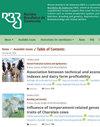Protein and energy for maintenance and gain of European quail fed different energy sources and housed at two temperatures
IF 1.2
4区 农林科学
Q3 Agricultural and Biological Sciences
Revista Brasileira De Zootecnia-Brazilian Journal of Animal Science
Pub Date : 2022-01-01
DOI:10.37496/rbz5120210183
引用次数: 0
Abstract
- The objective of this study was to evaluate whether replacing corn starch (CS) energy with isolated soy protein (ISP) and soybean oil (SO) and the ambient temperature affect the protein and energy requirements for maintenance and gain of European quail. Thus, a total of 432 European quail from 10 to 30 days of age, distributed in a completely randomized design, were used to estimate the protein and energy requirements for maintenance through the comparative slaughter methodology. The treatments consisted of three diets formulated with the replacement of CS, corresponding to 15% of the metabolizable energy in the diet, with ISP and SO, two controlled temperatures (26 and 35 °C), and three levels of feed supply ( ad libitum , and 70 and 40% of ad libitum intake), with four replicates of six birds. Protein and energy requirements for weight gain were determined from 160 European quail, slaughtered every five days at 10, 15, 20, 25, and 30 days of age. Birds were housed in four groups of 40 birds in a room with thermoneutral temperature (26 °C). The energy sources of the feed and temperatures studied affected protein and energy requirements for maintenance and gain of European quail. Replacing CS energy by 15% of dietary energy with SO results in lower protein and energy maintenance requirements for European quail at both temperatures. The protein and energy weight gain requirements of quail fed SO as an energy source is higher than CS and ISP.饲喂不同能量源和饲养温度对欧洲鹌鹑维持和增重的蛋白质和能量影响
本研究旨在评价用分离大豆蛋白(ISP)和豆油(SO)替代玉米淀粉(CS)能量以及环境温度对欧洲鹌鹑维持和增重所需蛋白质和能量的影响。为此,采用完全随机设计,选取432只10 ~ 30日龄欧洲鹌鹑,采用比较屠宰法估算其维持所需蛋白质和能量。试验分为3组,每组4个重复,每组6只,分别以15%的代谢能替代CS、ISP和SO配制3种饲粮,2种控制温度(26°C和35°C), 3种饲料供应水平(自由采食量的70%和40%)。在10、15、20、25和30日龄时,每5天屠宰160只欧洲鹌鹑,测定其增重所需的蛋白质和能量。这些鸟被分成四组,每组40只,被安置在一个温度为热中性(26°C)的房间里。研究了饲料能量来源和温度对欧洲鹌鹑维持和增重所需蛋白质和能量的影响。在这两种温度下,欧洲鹌鹑对蛋白质和能量维持的需求都较低,将15%的日粮能量用SO替代CS。以豆粕为能量源的鹌鹑对蛋白质和能量增重的需求高于豆粕和豆粕。
本文章由计算机程序翻译,如有差异,请以英文原文为准。
求助全文
约1分钟内获得全文
求助全文
来源期刊
CiteScore
1.90
自引率
0.00%
发文量
25
审稿时长
8 weeks
期刊介绍:
The Revista Brasileira de Zootecnia (RBZ; Brazilian Journal of Animal Science) encompasses all fields of Animal Science Research. The RBZ publishes original scientific articles in the areas of Aquaculture, Biometeorology and Animal Welfare, Forage Crops and Grasslands, Animal and Forage Plants Breeding and Genetics, Animal Reproduction, Ruminant and Non-Ruminant Nutrition, and Animal Production Systems and Agribusiness.

 求助内容:
求助内容: 应助结果提醒方式:
应助结果提醒方式:


